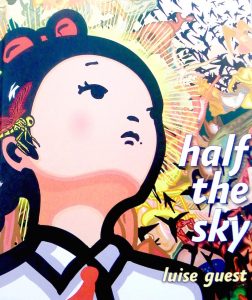As with all other aspects of global life, China has a greater impact today than it did 30 years ago. But Chinese artists, especially the women, are still an unknown quantity. Luise Guest tries to tackle this shortfall in knowledge with an intriguing and well-presented look in her book, Half the Sky. At 224 illustrated pages the book highlights the work, sometimes bizarre, always thought-provoking, of the gender in China that Mao claimed held up half the sky. Anyone who has visited China know they do more than that and the 32 artists featured in the book keep the sky from falling in ways you can barely imagine.
Guest knows her subject and has a gift to bring the reader on a journey with her. Take for instance the chapter titled Nushu: This is an obscure traditional female language used in the remote areas of Jiangyong County, Hunan province. The outside world discovered this language in the 1980’s just as it was fading out. The slanted script stitched on fans, handkerchiefs and clothbound books was given to brides to show marriage as a terrible fate.
Nushu allowed women to articulate their sorrow and anger at the stoic endurance of suffering expected of them and so the emphasis is more on duty at the expense of individual desire reinforcing Confucian sensibilities of obedient submission to familial authority.
Artist Tao Aimin’s Book of Women used wooden washboards collected from hundreds of rural women over many years. She has collected over a thousand of these artefacts of female history, and has recorded the details of each owner. Tao Aimin doesn’t see herself as a feminist artist although she is sensitive to the idea of female destiny, it is humanity male and female that is important. Tao has scrolls and books with the traces of ink on washboards and marks made by the act of printing suggesting mountains and misty waterfalls of literati landscape painting. By choosing Nushu as her calligraphy Guest writes of Tao “ She inserts a language invented by anonymous, unlettered rural women into the rarefied canon of the Imperial Scholarly tradition, bringing a largely unacknowledged female history into the light of day.”
Another artist in the Nushu spectrum is performance artist Ma Yanling. (I have worked with her on various projects over the years such as ‘Irish Wave’ exhibitions here in China and also ‘Intimate Transgressions’.) Also a photographer and painter, Ma Yanling’s ‘Suitcase Series’ shows the artist tightly bound with plastic tape or silk ribbon as she crams herself into small cupboards and suitcases. “These metaphors of bondage and confinement are feminist expressions of dissent in a country where dissent can come at a high price.” This series of work is included as one of the core artworks which are part of the travelling Intimate Transgressions Project which I have been writing about this past year. The next show will be at Chiang Kai Shek Memorial Hall Taipei Oct 2016.
Neither is the book heavy in it’s focus. The cover of the book is adorned with Bu Hua’s AD 3012 and the back cover her work Brave Diligent. Bu Hua along with Cui Xiuwen and Cao Fei are highlighted in the first chapter Alter Egos and Avatars offering worlds of paradox filled with humour, wit and pathos but also with tones increasing levels of anxiety. “Distanced from the collective past, they have embraced the pluralist possibilities of the present whilst remaining clear- sighted about its dangers.”
The fourth chapter Black as lacquer- Reinventing Ink looks at how the significance of ink painting and calligraphy in Chinese history continues to resonate with the reinvention of these ancient traditions. Ink artist Bing Yi’s work spans from meditative miniature contemplations to her vast scale site specific installations. She has even applied ink from a helicopter for some of her installations. Bing Yi lives and works in an old temple and her work is informed by Buddhist beliefs embodying the notion of eternity and in certain respects deals with the notion of detachment.
This book is a companion to anyone who wants to understand the forces driving a sector of the art world that is emerging from the dark corners. Guest deserves our gratitude that she was able to throw some light on it.
At the Red Gate Gallery “Half the Sky” exhibition in April where 16 of the artists in the book were featured .
With Luise Guest when she gave a book talk at the Beijing Bookworm in April 2016
Half the Sky – Conversations with women artists in China, by Luise Guest is published by Piper Press 2016.
Queensland Art Gallery/Gallery of Modern Art


